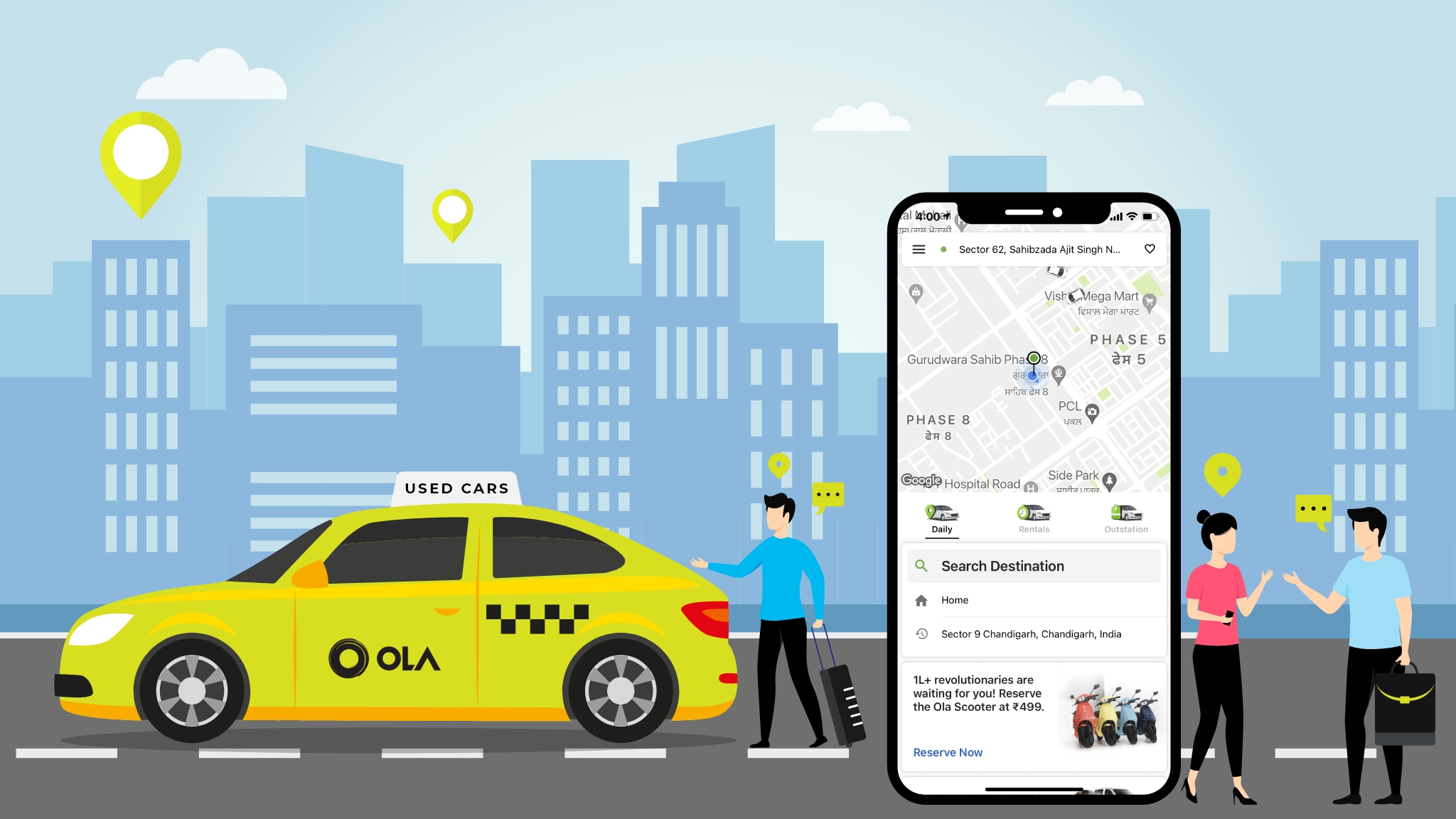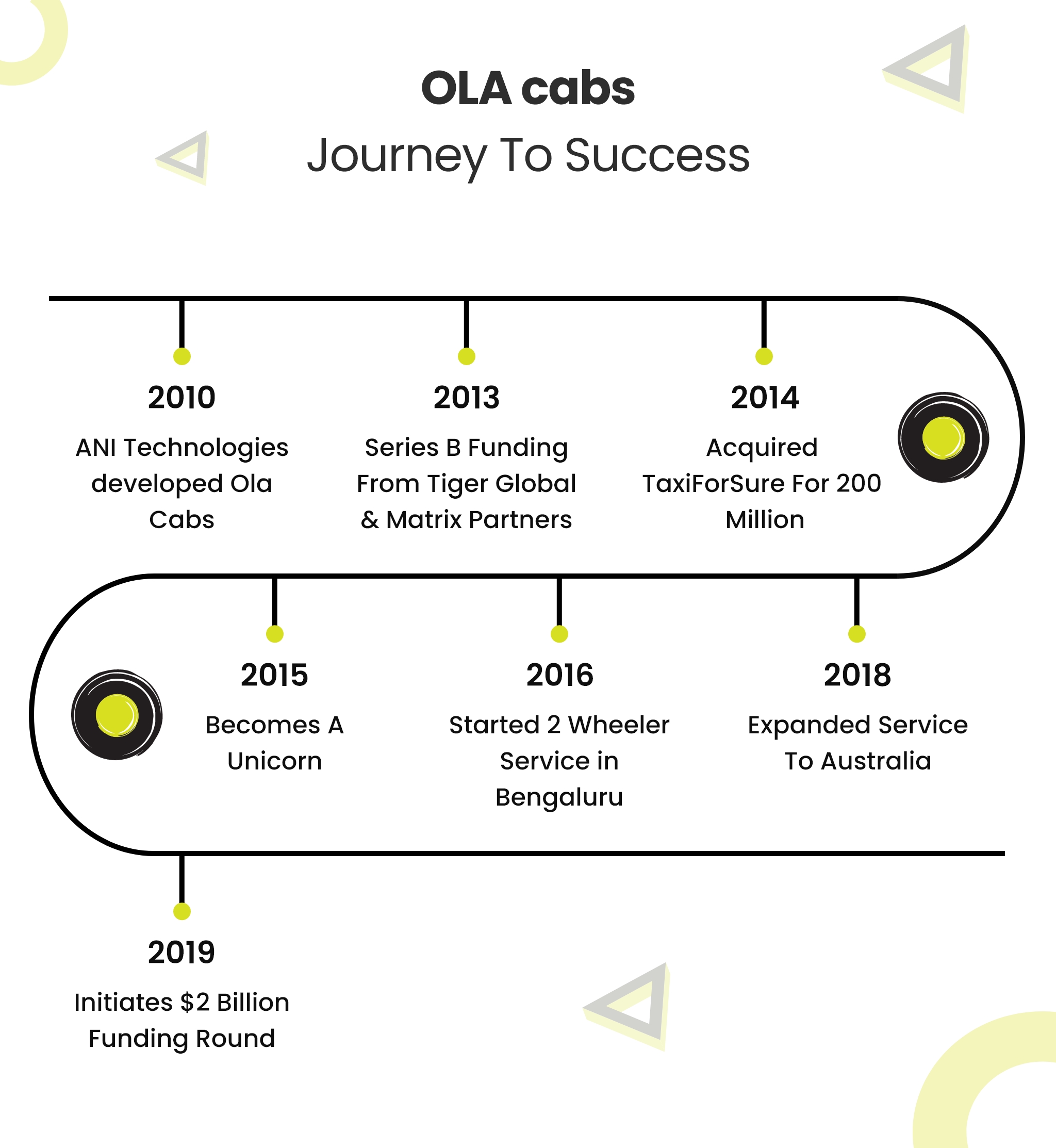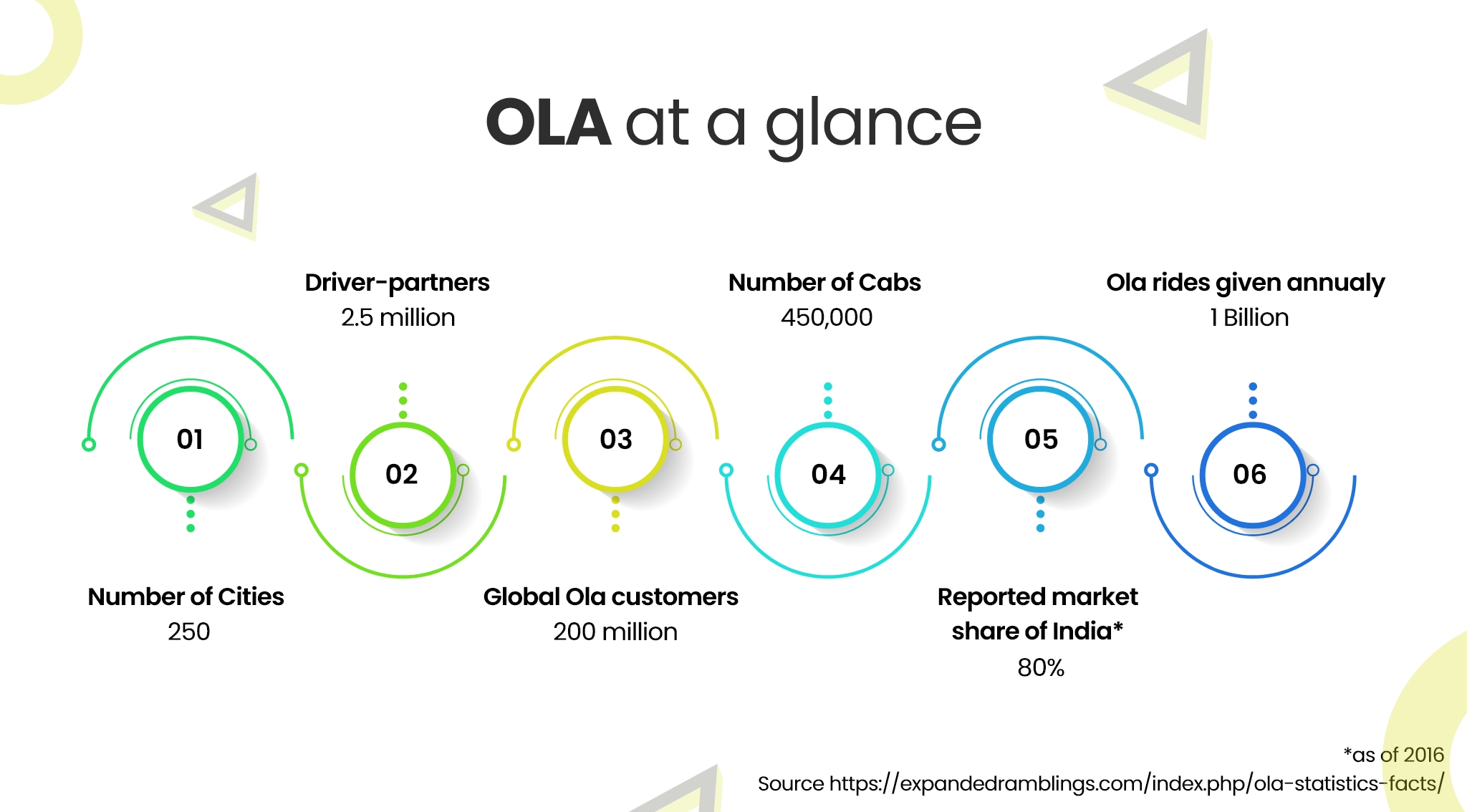Don't miss the chance to work with top 1% of developers.
Sign Up Now and Get FREE CTO-level Consultation.
Confused about your business model?
Request a FREE Business Plan.
What Is Ola Cars All About? | How Can You Make An App Like Ola
Table of contents

Many businesses are planning to get an app like Ola developed to excel in the taxi industry. But they are not aware of the strong business model and business strategy of Ola. In this blog, you will learn how Ola started, about its business and revenue model and what Ola Cars is all about.
Ola began its on-demand Taxi Booking Service by purchasing a fleet of vehicles. Initially, they provided services over the phone, but as the digital sector grew, they moved their operations online. They began addressing the needs of both drivers and consumers with this current two-way approach.
Carpooling and taxi rental services are presently thriving industries and that is why many businesses are planning to get an app like Ola. To escape traffic and long-distance travel, an increasing number of individuals are turning to taxi services. An app like Ola resonates with millennials because they expect ease and comfort in their travel at the touch of a button.
How Ola Started?
Bhavish Aggarwal’s entrepreneurial path began long before he entered the taxi rental sector. Before launching Ola Cabs, he founded an internet firm that sold short-term trips and vacations.
Bhavish needed to go from Bangalore to Bandipur to keep his holiday and tour organising business viable, so he leased a car, which ended in a disastrous experience. The driver pulled over in the middle of the road and asked that Bhavish’s fare be renegotiated. When he was rejected, he continued to abandon him en route to his goal.
This is when he realised that his situation was likely similar to that of many other customers across the country who were looking for a quality cab service but ended up with one that stood them up, arrived and dropped them off late, didn’t keep their promises, and came with drivers who were nightmares behind the wheel.
For the first time, he recognised the enormous potential that an exceptional cab booking service might have, and as a result, he shifted his business from his previous start-up to the one we now know as – OlaCabs.

This was in December 2010, when he was joined in his venture by co-founder Ankit Bhati. Of course, his parents did not agree with his plan at first, as many Indian parents do. They were furious at his choice to become a “travel agency,” but when OlaCabs secured its first round of investment from two angel investors, they began to believe in the difference he was trying to bring.
Instead of purchasing and renting out their vehicles, OlaCabs collaborated with numerous Taxi Drivers and added a touch of contemporary technology to the entire setup, allowing consumers to book cars at short notice through their call centres and their app. The bookings allowed for half-day and full-day rentals, as well as outstation taxis.
Inspiration For An App Like Ola To Grow In The Market
When Bhavish Aggarwal was in the middle of a terrible journey from Bangalore to Bandipur, he founded the homegrown cab aggregation business Ola Cabs.
Ola Cabs, then owned by ANI Technologies Pvt., Ltd., became the collective brainchild of Bhavish Aggarwal and Ankit Bhati. Ola rose from humble beginnings in 2010 to become one of India’s fastest-growing businesses, outpacing global competitors Uber and Meru Cabs.

So much so that, only four years after its inception in 2014, the firm has expanded to more than 100 cities, amassing a network of over 200,000 automobiles. By 2014, Ola had more than 150,000 bookings per day and had more than 60% of the market share in India.
Also, read – Ola – India’s Ride-Hailing App Is Now Backed By Investors From Dubai – All Set To Expand Internationally
What began as a cross-city cab aggregator rapidly expanded into micro cabs for city travel in Bangalore and Delhi NCR. Ola became India’s cheapest AC cab service with a base pricing of Rs.150 for the first six kilometres and an introductory price of Rs.12 per kilometre.
How Does An App Like Ola Cars Work?
We, being the best taxi booking app development company, give you a thorough understanding of the Ola cab business model and the Ola revenue model. This will give you a good sense of what you may incorporate into your future car rental app like Ola or taxi business.
Ola initially entered the market as a Taxi Rental Fleet Business. They purchased a fleet of automobiles and hired drivers. Customers had to call Ola’s call centre to reserve taxis, and cabs were delivered to their preferred location and time.
They identified a huge potential in the internet market in 2015 and shifted their entire operation to app-based aggregation. With this move, Ola began acting as a middleman between consumers and cab drivers, rather than acquiring their fleet of cars. Ola uses a smartphone application to connect drivers and passengers.
Here is a step-by-step explanation of how the Ola app works:
- Once a user has registered, there is an option in the mobile app to quickly identify the user’s position through GPS upon login.
- The consumer must specify the drop-off location. The app displays several taxi categories as well as their prices. The customer may now select a cab based on their needs and preferences.
- Following that, the customer’s request is routed to the driver.
- When a driver accepts the request, a confirmation message with the driver’s information is delivered to the customer through message or mail.
- The driver picks up the customer from the pickup point and returns the customer to the desired destination.
- Customers can pay the user using any payment method they prefer including online payment, cash, Ola money. etc.
This is how the business model of Ola cabs works and if you are planning to build an app like Ola, you must keep this in consideration.
Explained Revenue Model Of App Like Ola
Let’s take a look at the various income sources that Ola generates. If you want to develop an app like Ola then you must integrate this revenue model too.

Trip Commission
The income generated by Ola taxis is the most important component of the firm. The firm charges an X% fee, which fluctuates between 15-20% of the total fare depending on the car and location. Ola’s overall fair is dependent on a variety of criteria. These are as follows:
- Base Fare: This is a one-time fee that is collected at the outset.
- Total Time Of Ride: The whole time from pick-up to drop-off is taken into consideration when computing the total fare. The entire journey is calculated in a matter of seconds.
- Waiting Time: If a customer makes a driver wait, he or she will be charged for the time spent waiting.
- Fare Based on Distance per KM: This is paid per kilometre and varies depending on the city and the kind of vehicle booked.
- Demand for Cabs: The pricing at that moment is heavily influenced by the cab’s demand. Ola increases the cost of every kilometre travelled. It is designed to make a lot of money when there is a strong demand for cabs.
- Fee For Booking: If the consumer books the cab in advance, an advance charge is imposed.
- Convenience Fee: Taxis with in-cab entertainment are subject to a surcharge. The customer will be charged if they choose a pick-up and drop-off service to the airport.
- Toll & Parking Fee: This is based on the number of toll intersections crossed and the vehicle parking service used.
- Cancellation Fee: If a customer cancels a ride after booking, Ola charges a cancellation fee.
- Service Fee: A service tax, as well as other taxes, is charged on the whole cost of the trip.
In-Cab Advertisements
Brochures, pamphlets, and other promotional materials are distributed to passengers to promote various companies and goods. For commercial purposes, live advertisements are played throughout rides.
For these kinds of promotions, Ola earns a commission from each company. Ola obtains an extra revenue stream in this manner.
Credit Card
The firm has partnered with the State Bank of India and VISA to offer the Ola Money SBI Card, a credit card. Customers may earn a variety of incentives using the card. The Ola SBI Credit Card has no registration charge and an annual cost of Rs 499. Every person who pays with an Ola Money SBI Card receives a specific amount of commission.
Cab Leasing
The firm buys vehicles and then rents them to drivers. By doing so, Ola creates an asset value as well as a job market for drivers by allowing them to join the ola platform for a minimum membership fee of Rs X. As a result, the membership fee represents more money for Ola and this can be a great idea for your app like Ola.

Corporate Tie-Ups
Ola offered its Cab services to various corporations in the form of specific bundles and plans at a discounted rate, which their workers could take advantage of.
Ola benefits from increased sales volume as a result of these B2B collaborations, allowing the firm to earn consistent income.
Ola Money
Ola, like PhonePe, PayTM and FreeCharge, has introduced its wallet via which users can easily make payments to various vendors and cab drivers. Ola has partnered with a variety of online and offline retailers. When a user makes a payment through Ola Money to these businesses, the firm receives a portion of the income.
Ola Prime
Play Ola has partnered with Microsoft, Apple Music, Sony Digital, and other companies to provide passengers with tailored in-cab entertainment.
During travel, Ola ensures that all clients who are willing to pay a small charge have a comfortable and pleasurable experience. As a result, it plays a key role in increasing corporate income.
From OlaCabs To Ola Cars
Ola intends to grow outside its ride-hailing industry and into other markets. According to Entracker, Ola is about to establish a used-car sales company in Bengaluru. According to the article, this information was obtained from three persons who are familiar with the specifics of this new line of business.
This is also Ola’s first significant product launch in the previous two years, located in Bengaluru. “Ola is expected to join the market with a full-stack strategy, where it would acquire vehicles from individuals and the company’s driver-partners and sell them to consumers after any flaws are ironed out,” one insider told Entracker.
According to the sources, Ola has already begun assembling a team for the new vertical and plans to launch a pilot in Bengaluru in the second part of August. “Ola’s top management sees it as a supplementary business model to its main business — mobility,” said another source, adding that the used-car firm will be branded “Ola Cars.”
Ola will compete with firms such as Cars 24, Spinny and CarDekho in this new business endeavour. While Spinny has been in the game for a while, CarDekho has lately entered the fray, and Cars24 has also been in the game for a while. The used vehicle industry is only going to expand more. According to an Autocar study, the number of used vehicles in India may reach 8.2 million in FY25, up from 3.8 million in FY21.
Final Words
The firm has benefited by diversifying its operations. All of these income sources have assisted the company in increasing revenue and attracting people to its core business area, which is the cab booking service.
Ola now has the most market share in the country. Furthermore, the company’s revenue has risen tenfold in the previous four years. As a result, it has risen to become India’s largest on-demand cab booking service provider.
If you want to create an online vehicle rental and carpooling app like Ola, you may contact Apptunix, a competent mobile app development company. We have a pool of highly talented developers who will deliver the ultimate cab booking service app to maximise ROI.

Rate this article!
(2 ratings, average: 5.00 out of 5)
Join 60,000+ Subscribers
Get the weekly updates on the newest brand stories, business models and technology right in your inbox.

Lively and spirited. You may call me a tech-geek. I like to explore latest advancements in the technical areas and develop case studies. Being a computer science graduate, I like to traverse through the technical platforms as well. You can find me understanding or playing with the latest technology.

Telemedicine 2.0 - A Comprehensive Guide On What Healthcare Providers Need To Know?
Discover how the latest advancements like Artificial Intelligence in telemedicine are reshaping patient care. This comprehensive resource offers insights into the key trends and innovations driving this shift, providing valuable knowledge for healthcare professionals looking to stay ahead.
Download Now!Subscribe to Unlock
Exclusive Business
Insights!
And we will send you a FREE eBook on Mastering Business Intelligence.


















